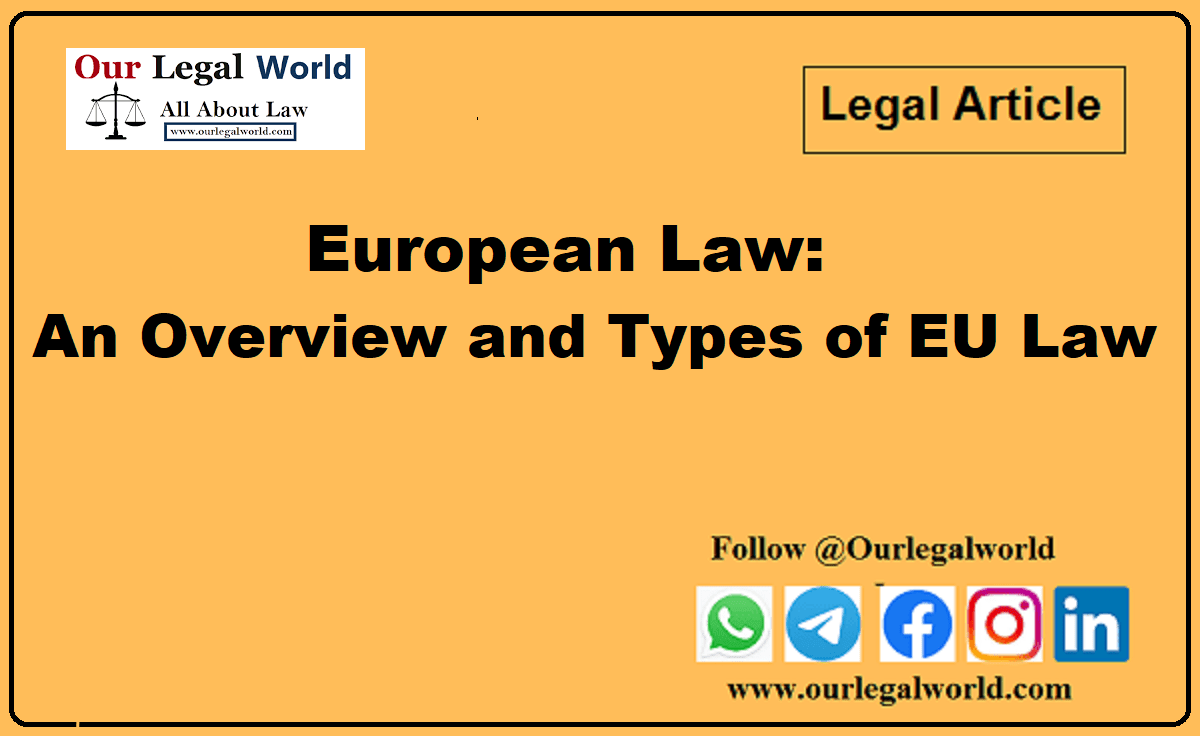European Union Law: An Overview and Types of EU Laws
What is European Union Law and types of EU law?
European law refers to the body of legal rules and regulations that apply within the European Union (EU) and its member states. It is a complex legal framework that governs various aspects of European integration, including trade, competition, environmental protection, human rights, and more. European law is based on a combination of treaties, regulations, directives, and case law developed by the Court of Justice of the European Union (CJEU). Here’s a detailed explanation of some key elements of European law along with examples:
Treaties:
The primary source of European law is the treaties that establish and govern the EU. The two most important treaties are the Treaty on the European Union (TEU) and the Treaty on the Functioning of the European Union (TFEU). These treaties set out the EU’s objectives, institutions, and decision-making processes. The treaties are negotiated and agreed by all the EU countries and then ratified by their parliaments, sometimes following a referendum.
Example: The Treaty of Lisbon, which came into force in 2009, amended the existing treaties and clarified the EU’s competencies, making it easier to adopt legislation in certain areas, such as justice and home affairs.
Regulations:
Regulations are binding legal acts that are directly applicable in all EU member states without the need for national implementing measures. They have uniform legal force throughout the EU.
Example: The General Data Protection Regulation (GDPR) is an EU regulation that governs data protection and privacy. It applies uniformly across all EU member states and sets out the rules for how personal data should be handled.
Directives:
Directives are legal acts that set out certain objectives that EU member states must achieve within a specific timeframe. Member states are responsible for implementing directives into their national laws.
Example: The Energy Performance of Buildings Directive requires member states to establish regulations to improve the energy efficiency of buildings. Each member state must transpose the directive into its national laws.
Case Law:
The CJEU interprets EU law and ensures its uniform application. It issues judgments that clarify legal principles and establish precedents for future cases.
Example: In the “Cassis de Dijon” case, the CJEU ruled that goods legally manufactured and sold in one EU member state must be allowed to be sold in other member states unless there are valid reasons for restrictions. This judgment contributed to the development of the EU’s single market.
Secondary Legislation:
Besides regulations and directives, there are other forms of secondary legislation, such as decisions, opinions, and recommendations, which have varying degrees of legal impact within the EU.
Example: The European Central Bank issues opinions and decisions on matters related to monetary policy and financial stability, which influence the economic policies of the eurozone countries.
Human Rights:
European law includes the European Convention on Human Rights (ECHR), which is separate from EU law but is an essential part of the legal landscape in Europe. The European Court of Human Rights (ECHR) oversees compliance with the ECHR by member states.
Also Read: International Law Notes, Case Laws and Study Material
Example: The ECHR has played a crucial role in cases involving issues like freedom of expression, the right to a fair trial, and protection against torture and inhuman or degrading treatment.
Conclusion
EU law covers a wide range of areas, including trade, competition, environmental protection, consumer rights, data protection, and more. It aims to create a single market, ensure the free movement of goods, services, capital, and people, and promote cooperation among member states in various policy areas.
The enforcement of European law is overseen by the European Commission, which can initiate legal proceedings against member states for non-compliance, and the Court of Justice of the European Union, which has the authority to resolve disputes and interpret EU law.
It’s important to note that European law is distinct from the national laws of each EU member state but takes precedence over them in areas where the EU has competence. Member states are expected to align their national laws with European law to ensure consistency and cooperation within the EU.
Reference
https://commission.europa.eu/law/law-making-process/types-eu-law_en





![Tax Law Internship at Legum Attorney [Chamber of Ashish Panday], Delhi : Apply by 15th May 2025](https://www.ourlegalworld.com/wp-content/uploads/2025/05/IMG_0113-min.png)

